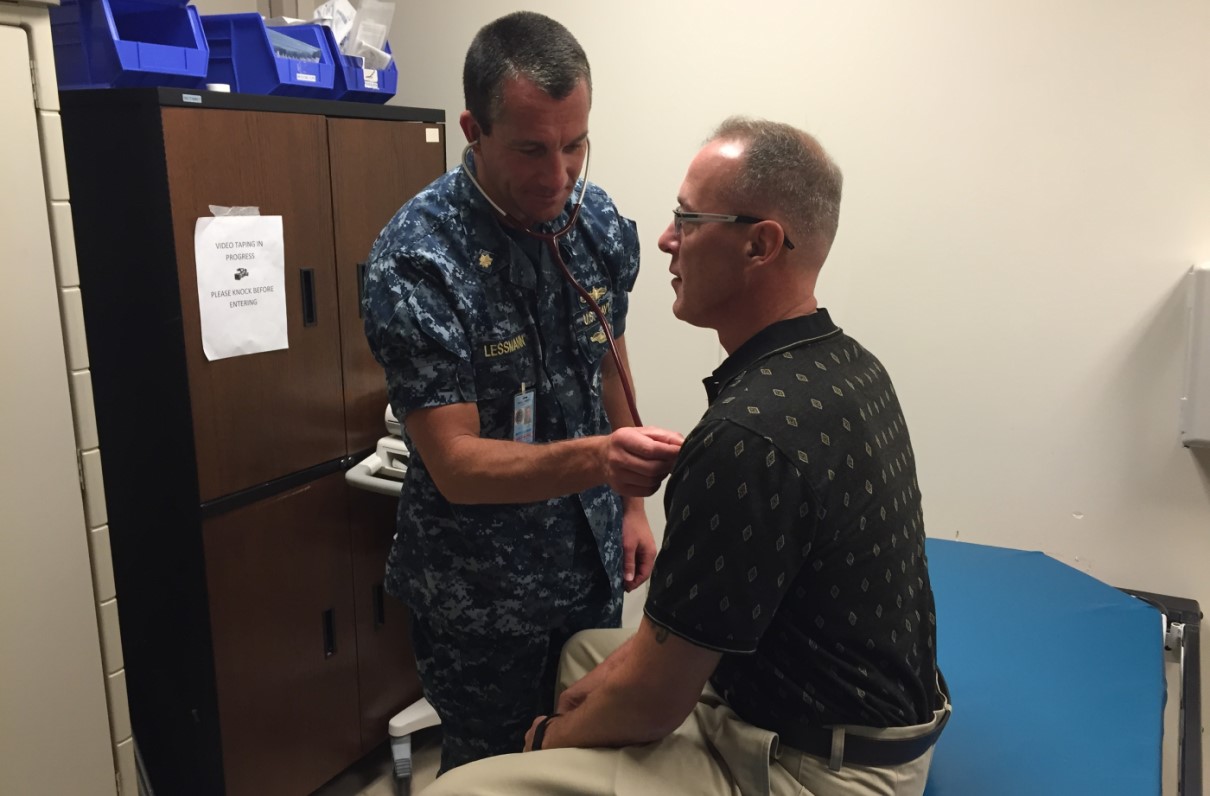 This article discusses one of MOAA's key Storming the Hill topics for 2019. For more about the topic and other areas of focus, visit our Storming the Hill page.
This article discusses one of MOAA's key Storming the Hill topics for 2019. For more about the topic and other areas of focus, visit our Storming the Hill page.
Congress has fairly consistently supported the principle that military retirees - by virtue of their service - should be recognized with some level of health care premium support. However, that level of support has always been vague, leaving it ripe for erosion.
Further, as a result of several years of TRICARE fee increases, today's working-age TRICARE retiree cost shares are closely aligned with the average civilian's cost shares and in proportion to civilian employers' cost of coverage.
We must resist the urge to compare military retiree health care cost shares with civilians'. The cost disparities between civilians and veterans cannot truly be compared; those who served have already paid their share of their health care premiums through decades of service and sacrifice - the true costs of which are significant.
[TAKE ACTION: Ask Your Lawmakers Not To Raise TRICARE Fees]
“While I realize I don't have much to complain about - $30 here and $30 there - [when it's] combined with increased prescription costs and the annual fee, [it] eventually [adds] up to real money,” says Capt. Craig Herrick, USN (Ret), of Mechanicsburg, Pa. “I appreciate the value of this earned benefit, and I'm concerned by the slow erosion.”
Basic Costs
In the civilian economy, approximately three of four full-time employees participate in employer-sponsored group health plans.
According to the Kaiser Family Foundation Employer survey, the typical employee paid about 29 percent of the company's total premium cost for family coverage in 2018; the employer paid the remaining 71 percent. Premiums for employer-sponsored health plans vary mostly by the type of coverage, individual or family.
Other health insurance premiums and out-of-pocket expenses for the average civilian family and the amount of cost shares (including pharmacy costs) for military retirees under age 65 are becoming much more closely aligned.
It also is important to note retirees age 65 and over continue paying some of the highest costs of all.
“In light of the original premise of TRICARE For Life - premiums already paid by service, 22 years, in my case - why am I being charged at all for Medicare Part B?” asks Cmdr. William Breed, USN (Ret), of Hyde Park, N.Y. “My wife and I have lived frugally and amassed a healthy nest egg; I can't help but think we are being penalized for planning our future.”
[RELATED: What President Trump's Budget Says About TRICARE]
Additionally, the newest generation of servicemembers retiring or considering retirement in the next few years have served the duration of their careers during post-9/11 wartime conflicts.
While all generations of servicemembers, veterans, and retirees have endured tremendous sacrifices for the nation, service in Iraq and Afghanistan during the the past 20 years has unquestionably affected servicemembers and their family members in ways not yet fully understood.
Here are some of the true costs this most recent cohort already has paid:
1. Deployments. In its annual Military Family Lifestyle Survey, Blue Star Families has consistently found servicemembers and spouses rank the amount of time away from family as their top issue of concern, followed by concern regarding military pay and benefits.
2. Transition. A recent survey by the Pew Research Center focusing on the transition from the military into civilian life found veterans who served after 9/11 have experienced difficulties readjusting to civilian life.
The model Pew used predicts a veteran who served in the post-9/11 era is 15 percentage points less likely than veterans of other eras to have an easy time readjusting to life after the military (62 percent versus 77 percent).
Additionally, two other factors have significantly shaped the reentry experiences of post-9/11 veterans but appear to have had little impact on those who served in previous eras: Post-9/11 veterans who were married while they served had a significantly more difficult time readjusting than did married veterans of past eras or single people, regardless of when they served.
[RELATED: MOAA's TRICARE White Paper (share the link)]
3. Physical health. It's not often recognized that those who have served for any amount of time in uniform, much less a full career in service, have a difference in their physical health status from civilians who have never served. MOAA, in partnership with the United Health Foundation, examined these differences across a number of domains using data from Centers for Disease Control and Prevention surveys from 2011-16.
The most recent iteration, America's Health Rankings Health of Those Who Have Served Report, was published in 2018. Overall, individuals who have served reported their general health was better than reported by their civilian counterparts. However, despite reporting better health, those who have served actually present higher rates of chronic disease than civilians, and few improvements have been made on many important markers of good health.
Many chronic disease rates for those who have served indicate significant differences, especially among veterans over age 50, whose rates are even more disparate from their civilian counterparts
4. Mental health. The report also noted, “Both men and women who have served have higher rates of depression, anxiety, and frequent mental distress than civilian men and women.” Since the first time MOAA and United Health Foundation examined these numbers, in 2011-12, the rate of depression among those who have served has increased as much as 32 percent among those ages 26-34, and 9 percent overall.
During this time, little improvement has been observed in rates of anxiety and frequent mental distress among those who have served.
[RELATED: MOAA Survey: Satisfaction with TRICARE Costs Keeps Falling]
A Need to Change
Military health care costs have decreased and leveled off since 2010. The Defense Health Agency (DHA) has even reprogrammed funds from end-of-year health care savings back into DoD to be used for readiness. In 2018 alone, the DHA reallocated $870 million, which was then spent on night-vision goggles and put back into the DoD working capital fund. It was not invested back into the health care program nor provided to beneficiaries to lower their costs.
“The two major complaints that I hear from providers [are] that the referral submission procedures seem to change on a daily basis and that TRICARE pays less than Medicare. The latter issue is such that many providers are losing so much money that they are either reducing services provided or dropping from TRICARE,” says Maj. James B. Carr, USA (Ret), of Valdosta, Ga.
Through the years, adjustments have been made to TRICARE in terms of managed care contractor changes, TRICARE regional office configurations, and where TRICARE Prime would be offered. However, as a result of the 2017 National Defense Authorization Act (NDAA), TRICARE has experienced its greatest reforms since its inception.
The model has now changed for beneficiaries. For example, TRICARE beneficiaries are required to declare their TRICARE health care option during mandated open-enrollment periods, as is commonly done in civilian health plans.
Importantly, major structural changes have occurred in the military health system simultaneously with TRICARE benefit changes.
TRICARE contract oversight, as well as control of military treatment facilities, now will be completely executed under DHA's authorities, as was legislatively mandated in the 2017 NDAA.
DHA believes it can better prepare for future budget strategies by consolidating enterprise-wide functions such as pharmacy and information technology. The objective is to reduce duplication and create greater savings and efficiencies across the system.
The beginnings of those savings, which include increases in pharmacy and TRICARE cost shares paid by beneficiaries, are being realized by DoD. As of FY 2017, they have remained ahead of schedule.
“Ever since our contractor switched, we have had an incredibly difficult time getting payments processed on referrals - multiple calls and resubmissions, and payments coming six months late. Makes me wonder how many people give up fighting for our benefits and just pay to avoid being turned into collections,” says Chief Warrant Officer 2 Brian K. Slaybaugh, USA (Ret), of Gettysburg, Pa.
[TAKE ACTION: Visit MOAA's Legislative Action Center]
In a robust economy, employers compete for the best and the brightest employees by offering ever-expanding compensation packages.
People will realize the threat to their well-being associated with being in the military is not worth the benefits if their compensation differs only marginally from what is available in the civilian sector.
“Those looking at military budgets and ways to reduce costs have no clue as to what happens to retirees when they turn 65, and what the true costs are for the programs set in place,” says Lt. Col. George Glann Jr., USA (Ret), of Fayetteville, N.C.

